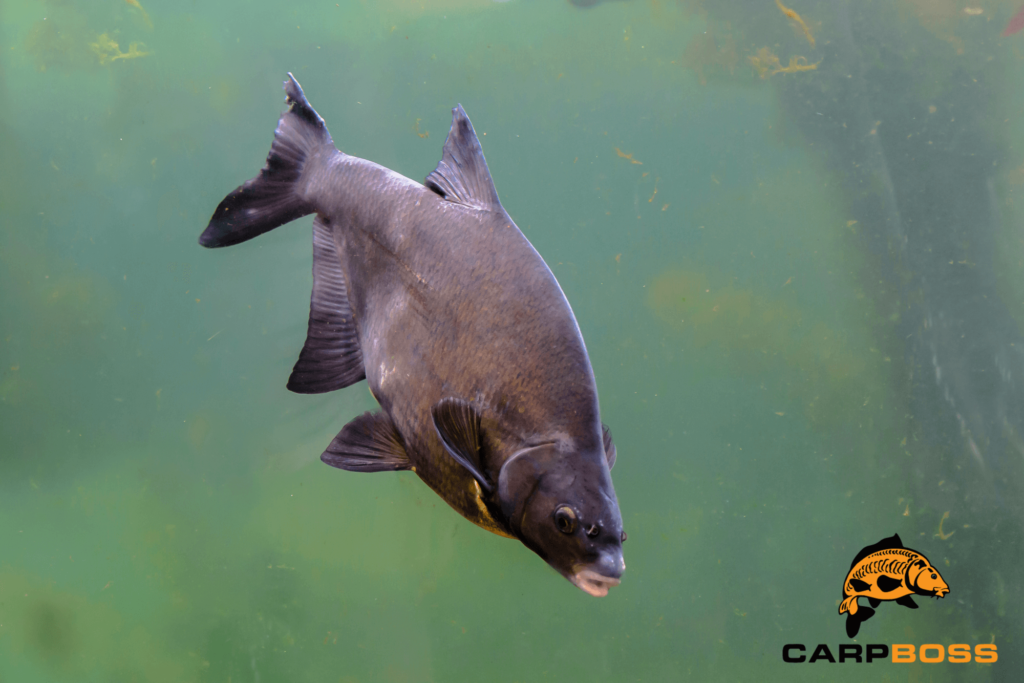Bream is a fish species often referred to as “nuisance fish” among carp anglers. They feed with similar baits as to those used for carp and once they get on your feeding spot you’ll catch more than a couple of breams. Join me as I explore how to avoid bream when carp fishing so that your campaign doesn’t turn into bream fishing.
The Difference Between Carp and Bream
One noticeable difference is the size of their mouths. Carp have significantly larger mouths compared to bream, allowing them to consume larger baits such as 30mm boilies which makes boilie feeding easier.
This difference in mouth size can impact their feeding behavior, as carp are more likely to take in bait in one swift motion, while bream may pick up a single boilie or tiger nut, feel the hair, and spit it out without coming near the hook. This means that bream bites are often very shy and sometimes you won’t even notice that you have hooked bream on the end of your line. Of course, larger specimens don’t count and they’ll bite will be very similar to that of a carp.
Additionally, the feeding habits of carp and bream vary. Carp are known to feed at various levels in the water, including mid-water, making them more likely to take a pop-up boilie on a zig rig. On the other hand, breams tend to feed closer to the lake bed and may be more attracted to smaller baits such as 2-4mm pellets or broken boilies. Using a method feeder with a raised hook bait on a zig rig could help target carp and keep bream at bay.
Avoid Bream When Carp Fishing by Choosing the Right Bait and Hook
Selecting Effective Boilies
When it comes to selecting boilies for carp fishing, it is important to choose flavors that are attractive to carp, such as molasses, scopex, strawberry, or mulberry. These sweet-smelling and tasting baits are often irresistible to carp. But, it is important to note that breams also eat boilies, but not as readily as they do other baits like pellets (except halibut pellets) or particles.
For a more effective carp fishing experience, opt for larger boilies (18-20mm) and avoid fishmeal-based ones. Adding black pepper or hot chili to homemade boilies can also help deter bream. Additionally, cooked tiger nuts with a few pints of hemp oil can also be a successful bait choice for targeting carp over bream.
In conclusion, while bream may still be attracted to boilies, selecting the right flavors and sizes can help increase your chances of targeting carp over bream. I want to point out that you should avoid bread bait at any cost if there’s bream in the water where you are looking for carp. Bread attracts bream more than it attracts carp even when you add additives in it.
Using Hook Baits That Deter Bream
When fishing in waters where there’s a lot of bream activity, it is important to use hook baits that deter them from taking the bait. Bream has a fondness for sweet baits, so opting for savory flavors is a good option. Keep in mind that deep water pellets are awesome bream bait so try to reduce their usage of them as much as possible. By adapting your hook baits to deter bream, you can increase your chances of targeting other fish species, such as carp.

Adjusting Your Fishing Approach to Avoid Bream When Carp Fishing
Setting Up Rigs to Target Carp
When setting up rigs and carp is your target fish, but the water is rich with bream, you must do everything in your power to create a rig that has a higher chance of hooking carp. One strategy is to use larger baits, such as 20mm or even 30mm boilies, and use either zig rig or pop-ups as much as you can. As we already said, bream feeds at the bottom, so presenting your bait above it is a good approach.
Also, tiger nut is irresistible to carp while on the other hand, it won’t attract bream as much. Bream anglers report they do catch bream on tigers, but this is a rare occurrence.
So this rig setup should do you good if you are targeting carp in bream water.
- Present your bait above the water bed. Use either a long leader with a pop-up or a zig rig
- Use big bait that bream can’t swallow easily
- If you are using additives, avoid sweet aromas
- If you fish in a catch and release water, tie barbless hooks so the fish doesn’t damage too much when taking the bait
Using Baiting Tactics to Attract Carp
When it comes to attracting carp, using the right baiting tactics can make all the difference. As mentioned in the background info, choosing the right type of feed bait is crucial. One effective tactic is to soak your baits in Cap-Oil and roll them in Krill Powder for added attraction. This not only gives your baits a boost in flavor but also helps deter bream and tench from stealing your bait.
In addition to the bait itself, the presentation of your bait is also important. Allowing your baits to dry on a plate can give them a flat edge, which can help with how the bait sits in the water and make it more enticing to carp.
When it comes to bait selection, a mixture of maize, broken boilies, and larger baits like 24mm Krill baits can be effective. Maize is a cost-effective option for baiting heavily when dealing with nuisance fish like bream and tench. Using a combination of different baits can help attract carp while deterring unwanted fish.
Overall, using a combination of baiting tactics such as soaking baits, choosing the right bait mixture, and adjusting your rig setup can help attract carp while avoiding bream and tench. Also, if you have enough time and the water where you fish is close by, try feeding regularly for a couple of days. This will create a feed spot for carp and next time your rods are in the water, you are bound to get the catch. By being strategic in your baiting approach, you can increase your chances of landing more carp on the bank.
Avoid Bream When Carp Fishing by Identifying Bream Hotspots and Avoiding Them
It is important to be aware of bream hotspots, or how I like to call it “bream city” in order to avoid them. Bream are often found in areas with features such as gravel bars, deep water, and structure like trees or bushes. These areas provide bream with a sense of security and are prime feeding grounds for them.
To avoid bream hotspots, it is recommended to stick to using boilies or tiger nuts as bait. Bream have a preference for mixed pellets and particles, so by avoiding these types of bait, you can decrease your chances of attracting bream to your swim. Additionally, using boilies in a PVA bag for casting out can help target carp specifically. This will create beds of boilies which, if big enough, will defer bream from the feeding spot.
It is also important to consider the depth, tow, and vulnerability to the chilling winds of the water you are fishing in. These factors can impact the likelihood of bream being present in certain areas. By understanding the conditions of the water, you can better determine where to fish to avoid bream hotspots.
Overall, by being mindful of bream hotspots and adjusting your bait approach and fishing strategy accordingly, you can increase your chances of catching carp while minimizing the risk of catching unwanted bream.

Pingback: Can You Use Carp Rods for Barbel Fishing? - Carp Boss